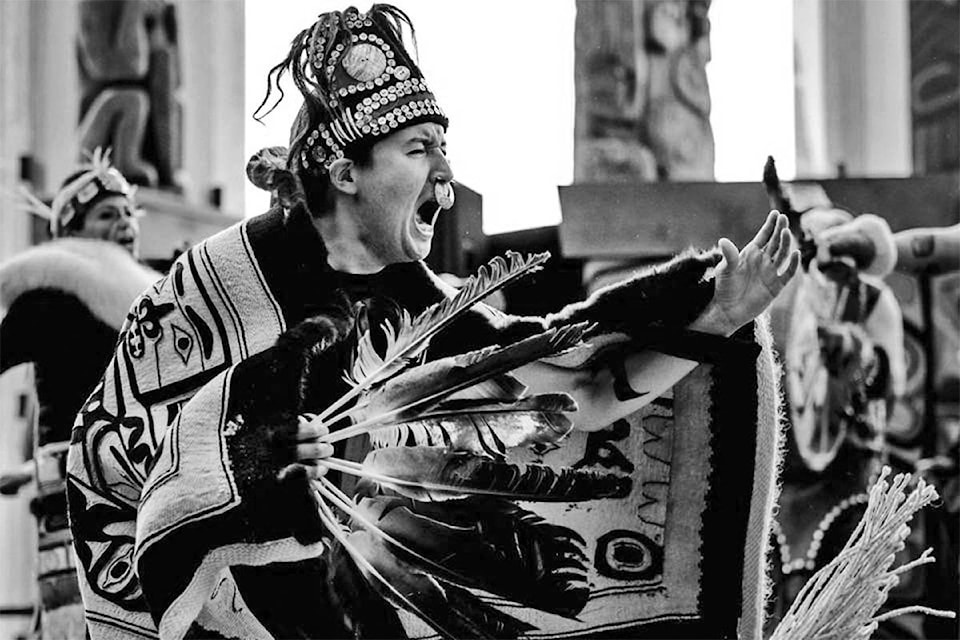Reproduction is the linchpin of Blake Shaá’koon Lepine’s first solo exhibit at Arts Underground. There is a lot to be unpacked here. The word oscillates between the literal and figurative — from how the artwork was produced to the circumstances surrounding the process.
He’s churned out his recent works, riding in a similar vein of Andy Warhol’s play on mass produced art (a criticism of consumerism.) The title of the show, Factory Life, is very much intentional. Lepine called the exhibit an “homage to Warhol.”
But there’s a twist. It’s also metaphoric but pivots away from Warhol’s pessimism.
“Raven in Disguise,” the centerpiece of the exhibit, which opens on Sept. 6, is a block print of a woman’s reproductive system. Lepine — a carver, painter and printer, among other things — coupled this with his recent becoming of dad to a second child, which, in turn, he said, punched his art making into overdrive.
“The reproductive cycle is like, you know, the way that we reproduce as human beings, our art becomes like our children and we want to maintain that integrity and not just reproduce for the sake of reproducing,” he said. “You spend so much time on it, working on it, developing it, then you have to let it go into the world.”
The depiction has already stirred controversy. A rendition of the work appears on the show poster.
“I’ve had a lot of people that are upset with my use of the female reproductive system with that title (of the show). Those people who have already given negative comments, I want them to come and hear what I have to say. They can tear me apart at the show if they want to. I don’t mind. Part of our work as artists is to take all the good with the bad.”
He chose to call the actual piece what he did in order to revive the use of the raven in traditional Tlingit stories. Knowing this is key to understanding Lepine’s art. It’s Indigenous art, yes, with a contemporary bent.
“I’m trying to modernize a lot of our art because I think a lot of artists in my field they kind of get trapped in this re-creating the past,” he said. “You know, they all want to create the old masks, the old totem poles, stuff like that. They just want to reproduce what we’ve already done. There’s a legion of young artists in my age category that are trying to, like, create the stories of today more than the stories of old.”
So he turned to the raven, a shape-shifting entity in Tlingit culture that can take on the form of, well, anything.
“It could be a pebble on the ground, a star on the sky, whatever.
“There’s no new stories of raven and what he’s up to. What I did is call it ‘Raven in Disguise’ because that’s where all human creation is, you know, from that female reproductive system.”
There are more works, a lot more.
Another tackles the subject of water is life.
“There’s not a lot of respect given to something that gives you life and doesn’t ask anything in return,” Lepine said. “Water, I think, is the most magical thing in existence, really, because it’s touched pretty much everything on the planet.”
To get the message across, he’s made a printed image of a water molecule with spirit figures arranged inside the atoms.
When the Missing and Murdered Indigenous Women and Girls inquiry came to Whitehorse, Lepine said it messed him up.
“I was really depressed and was trying to heal from it.”
He was re-doing the flooring of his home at the time. Lepine said math isn’t his strong suit and bought more laminate flooring than needed.
Lepine was painting in the basement when “My sweetheart came down. She just wanted to know I was OK, and I said, ‘Yeah, I’m fine, just gonna work on some stuff.’ She said, ‘Why are you painting on something that’s walked on?’ Just in that instant I had an immediate idea that, yeah, I love that idea of taking something that was walked on, and it was kind of like how our people have been trampled all over in this country for past 150 years.”
Three pieces, part of a series that will close after the exhibit, will be displayed. They depict animals. Lepine wouldn’t say more than that, not wanting to spoil it.
In total, there are four originals that will hang at Lepine’s show. The rest are prints replicated in different colours.
“That’s going back to the metaphor of children. Each one is unique. It has its own set of colours, set of gifts,” he said.
There’s more to say about what’s included in the exhibit, but we’ll stop there. See for yourself, support.
Jordan Steven’s pop art is going to be shown at the same time.
Lepine wants everyone to go.
“I’m trying to get people in the door that are not Indigenous, because, one, I wanna share art with them, but, two, it’s about creating that awareness of Indigenous people and for Indigenous art that we have spent thousands of generations developing this art form. To me, it’s a perfect art form because it can fit on anything, it can interpret anything and it’s a really unique way of seeing the world. I want to create spaces where everybody feels welcome.”
The opening reception for Factory Life by Blake Nelson Shaá’koon Lepine in Arts Underground’s Focus Gallery and Drip Drop Pop by Jordan Stevens in the Edge Gallery is happening Sept. 6 from 5 to 7 p.m. Both shows run from Sept. 6 to 28.
Contact Julien Gignac at julien.gignac@yukon-news.com
